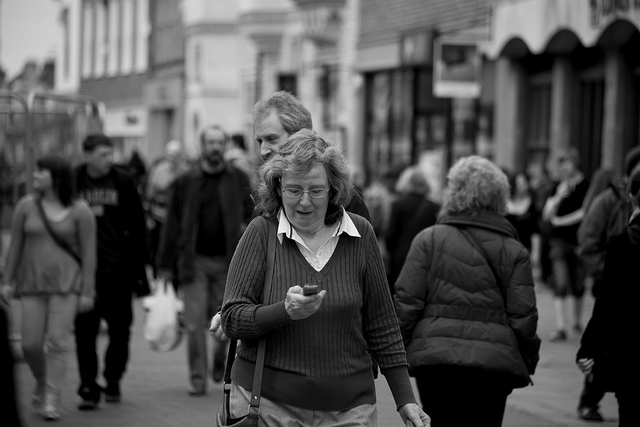Stop Texting While You’re Walking
Texting while walking is pretty obviously a bad idea - but just how bad is it?

Image: Mark Hooper
When you’re a kid, you learn how to cross the street properly: always look both ways. But as adults, many people disregard looking both ways in favor of looking at their phones. Texting while walking is pretty obviously a bad idea – but just how bad is it? Well, in Seattle, they did a little study to find out. Here’s Pacific Standard:
The study involved researchers sitting on 20 intersections and watching people cross the street, and recording whether they paid more attention to traffic or their devices. Apparently people spend two seconds more at an intersection when texting, which isn’t so bad. But they also were 400 percent more likely to miss looking at stoplights, stay in crosswalks or check the traffic.
Did you catch that? Four hundred percent less likely look at stoplights or traffic and to stay in their crosswalk. Even in the lab, we’re really bad at texting and not getting hit by cars, says this study from Accident Analysis & Prevention:
Participants distracted by music or texting were more likely to be hit by a vehicle in the virtual pedestrian environment than were undistracted participants.
Cell phones also change the way we walk, says one study from Gait and Posture. Turns out texting makes us walk slower and less able to walk in a straight line:
Participants engaged in cell phone use presented with significant reductions in gait velocity (texting: 33% reduction, p=0.01; talking: 16% reduction, p=0.02). Moreover, participants who were texting while walking demonstrated a 61% increase in lateral deviation (p=0.04) and 13% increase in linear distance traveled (p=0.03).
Of course, we know that texting and walking is a bad idea. That’s part of why we slow down. One study suggests, however, that even these extra precautions won’t change the likelihood of accidents:
Our results revealed that texters were more cautious than non-texters; they walked slower and rotated their body through doorways they could have safely walked straight through. There were no significant differences, however, in the number of bumps into the doorframes. If texters in the real world behave like those in our laboratory, then the number of texting-related accidents reported in other studies might suggest that being overcautious while texting does not actually decrease the likelihood of accidents.
The New York Times summarized a 2010 study on just how many people get hurt from walking and talking (or texting):
Slightly more than 1,000 pedestrians visited emergency rooms in 2008 because they got distracted and tripped, fell or ran into something while using a cellphone to talk or text. That was twice the number from 2007, which had nearly doubled from 2006, according to a study conducted by Ohio State University, which says it is the first to estimate such accidents.
So that texting and walking you’re doing? Stop it. Unless you have this app, which allows you to see what your phone is blocking:
Actually, don’t use this, either. You should still look both ways before you cross the street.
More from Smithsonian.com:
The First Text Message, Sent Twenty Years Ago, Was ‘Merry Christmas’
Having Trouble Finding the ISS in the Night Sky? Have NASA Text You
/https://tf-cmsv2-smithsonianmag-media.s3.amazonaws.com/accounts/headshot/Rose-Eveleth-240.jpg)
/https://tf-cmsv2-smithsonianmag-media.s3.amazonaws.com/accounts/headshot/Rose-Eveleth-240.jpg)